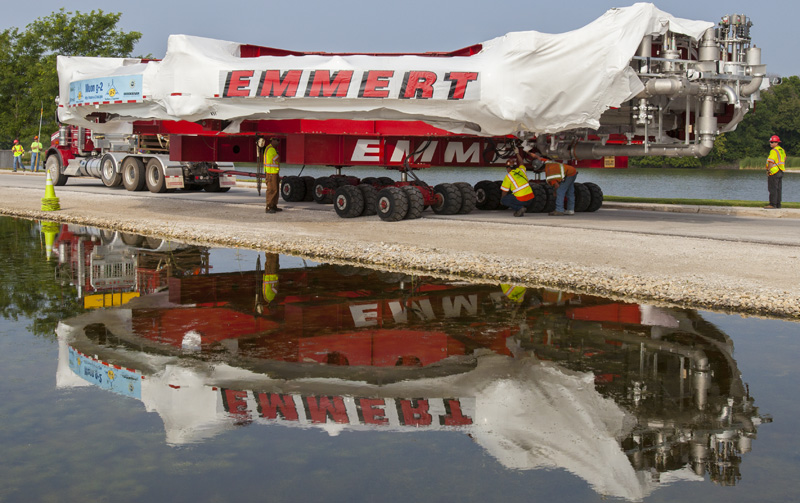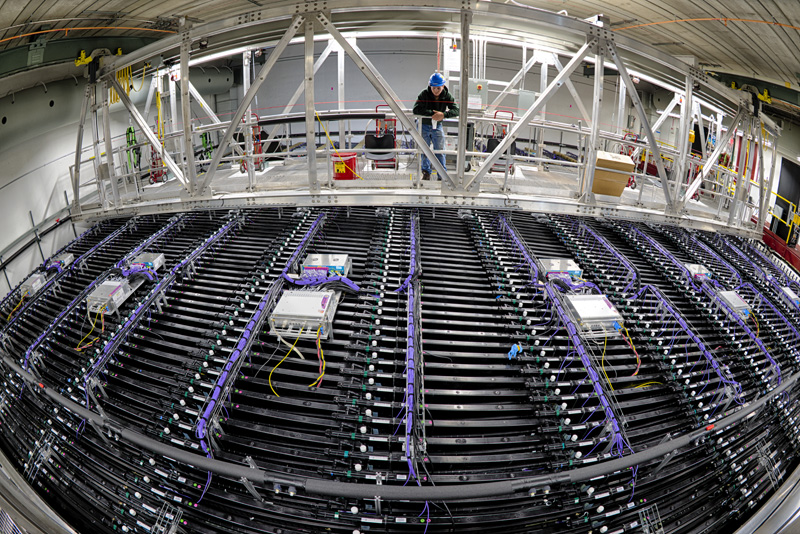Intensity Frontier
Image courtesy of Fermilab.
Shown in the final stage of its 3,200 mile journey from Brookhaven National Laboratory to Fermilab, this 50 foot wide electromagnetic storage ring is the heart of the Fermilab Muon g-2 precision measurement experiment.
Researchers at the Intensity Frontier investigate some of the rarest processes in nature, including unusual interactions of fundamental particles and subtle effects that require large data sets to observe and measure. First hinted at in the late 1960s by the result of Ray Davis’s Homestake Experiment under the Black Hills of South Dakota, researchers have demonstrated that the ghostly neutrino particles change between their three types as they travel, a phenomenon called neutrino oscillation. Understanding this process in detail may hold the key to explaining why all of the antimatter created in the big bang has disappeared, leaving the matter dominated universe we live in today. Precision measurements of particle properties, such as the magnetic moment of the muon (a heavy cousin of the electron), are capable of determining whether the Standard Model of particle physics is truly complete and may provide the first hint that there are undiscovered particles waiting to be found. Whether the focus is on precision measurements or the study of rare interactions, Intensity Frontier efforts require the use of powerful particle accelerators and ultra-sensitive detectors to reach their goals and enable discovery.
Of all known particles, neutrinos are perhaps the most enigmatic and certainly the most elusive. They have very low, but non-zero, masses and interact so weakly with matter that a light-year of lead wouldn’t stop most of the neutrinos in the world’s most intense neutrino beam, made at Fermi National Accelerator Laboratory. This weak interaction drives neutrino oscillation experiments to use intense neutrino sources, such as nuclear reactors and particle accelerators, and sensitive detectors, which may be located near or hundreds of miles from the neutrino source and perhaps deep underground.
Image courtesy of Fermilab.
It takes less than three milliseconds for the world’s most intense beam of neutrinos, made at Fermilab, to travel 500 miles to the 14,000 ton NOvA detector in Ash River, MN.
Each different combination of neutrino source and detector focuses on discovering more about a specific aspect of the nature of neutrinos. Current experiments not only advance our understanding of neutrinos, but develop the key technologies needed for the U.S. to host a world-leading neutrino program that includes an international long-baseline neutrino facility that takes full advantage of the world’s highest intensity neutrino beam at Fermilab.
Intensity Frontier researchers also explore the unknown in search of new particles and forces by making extremely precise measurements of particle properties and studying some of the rarest particle interactions. Making precise measurements of known particles allows researchers to determine whether the Standard Model road map is complete. Some particle interactions predicted to be extremely rare in the Standard Model of particle physics would be significantly enhanced if new particles or forces exist. In some experiments, finding even a single one of these special interactions may be the first indication of new physics. Other experiments apply the same principle to extremely precise measurements of fundamental particle properties, where measuring a deviation from the Standard Model’s prediction would indicate that new particles exist.
Intense beams of particles also offer a way to search for certain types of dark matter. Some proposed models of dark matter include new “dark” particles and forces that have ultra-weak couplings to normal matter. These models can be explored by using intense particle beams produced at U.S. national laboratories and highly capable, high rate detectors in a way that complements research efforts in the Cosmic and Energy Frontiers.
The Intensity Frontier supports instrumentation projects and operates experiments that further the science and enable discovery. The High Energy Physics Advisory Panel (HEPAP) advises the DOE on Intensity Frontier program status and direction.






